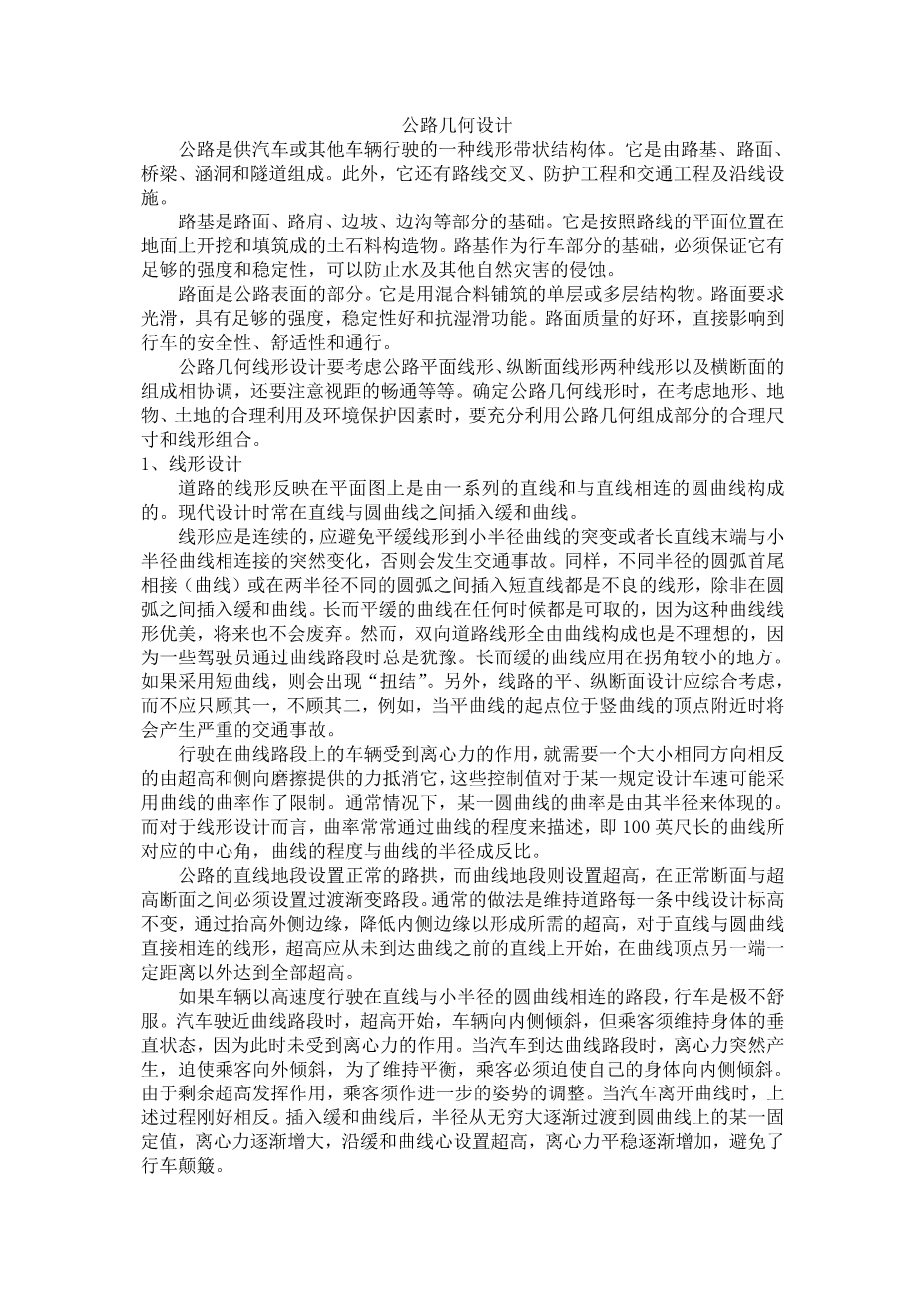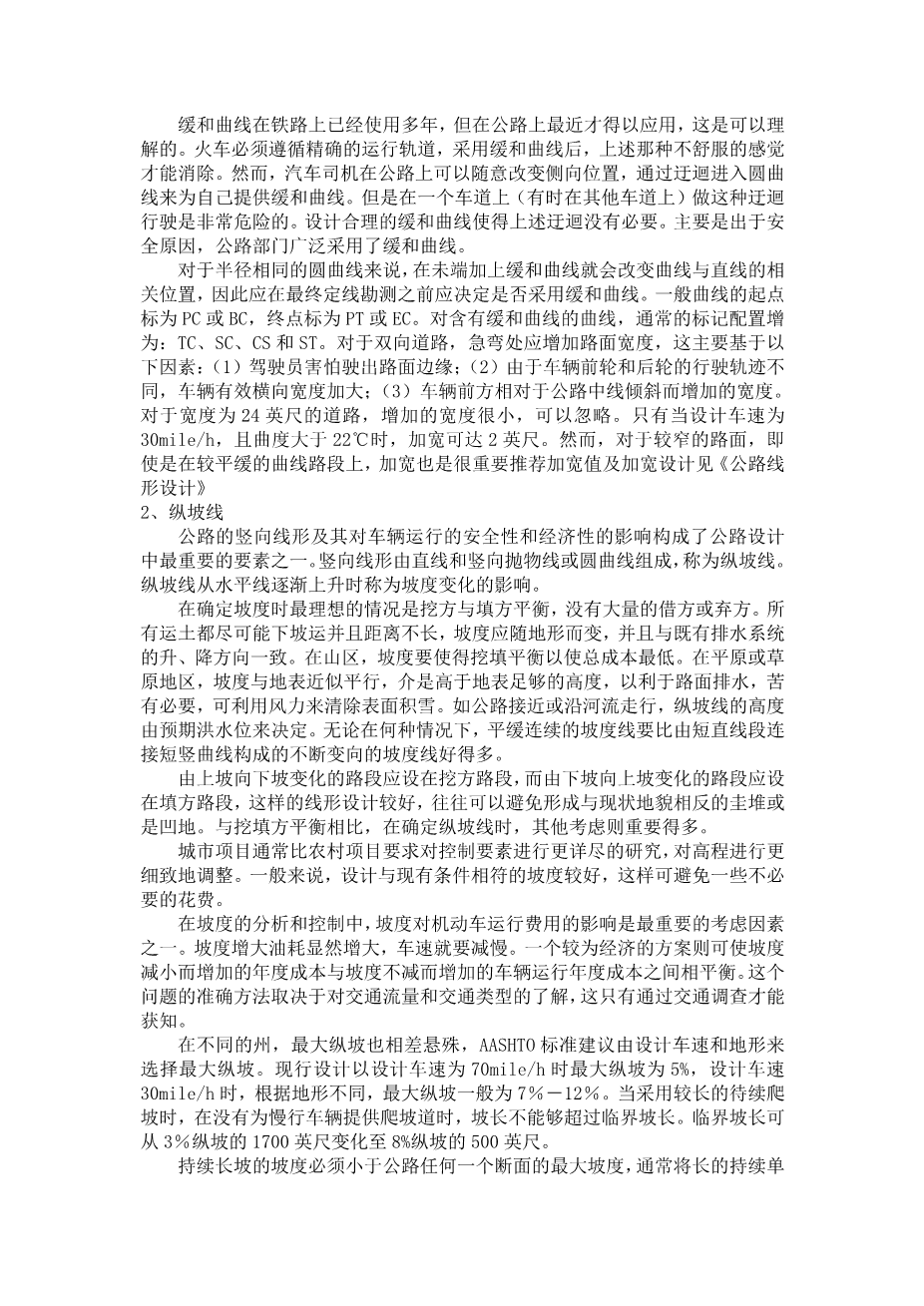Geometric Design of Highways
The road is one kind of linear construction used for travel. It is made of the roadbed, the road surface, the bridge, the culvert and the tunnel. In addition, it also has the crossing of lines, the protective project and the traffic engineering and the route facility.
The roadbed is the base of road surface, road shoulder, side slope, side ditch foundations. It is stone material structure, which is designed according to routes plane position .The roadbed, as the base of travel, must guarantee that it has the enough intensity and the stability that can prevent the water and other natural disaster from corroding.
The road surface is the surface of road. It is single or complex structure built with mixture. The road surface require being smooth, having enough intensity, good stability and anti-slippery function. The quality of road surface directly affects the safe, comfort and the traffic.
Highway geometry designs to consider Highway Horizontal Alignment, Vertical Alignment two kinds of linear and cross-sectional composition of coordination, but also pay attention to the smooth flow of the line of sight, etc. Determine the road geometry, consider the topography, surface features, rational use of land and environmental protection factors, to make full use of the highway geometric components of reasonable size and the linear combination.
1.Alignment Design
The alignment of a road is shown on the plane view and is a series of straight lines called tangents connected by circular. In modern practice it is common to interpose transition or spiral curves between tangents and circular curves.
Alignment must be consistent. Sudden changes from flat to sharp curves and long tangents followed by sharp curves must be avoided; otherwise, accident hazards will be created. Likewise, placing circular curves of different radii end to end (compound curves) or having a short tangent between two curves is poor practice unless suitable transitions between them are provided. Long, flat curves are preferable at all times, as they are pleasing in appearance and decrease possibility of future obsolescence. However, alignment without tangents is undesirable on two-lane roads because some drivers hesitate to pass on curves. Long, flat curves should be used for small changes in direction, as short curves appear as “kink”. Also horizontal and vertical alignment must be considered together, not separately. For example, a sharp horizontal curve beginning near a crest can create a serious accident hazard.
A vehicle traveling in a curved path is subject to centrifugal force. This is balanced by an equal and opposite force developed through cannot exceed certain maximums, and these controls place limits on the sharpness of curves that can be used with a design speed. Usually the sharpness of a given circular curve is indicated by its radius. However, for alignment design, sharpness is commonly expressed in terms of degree of curve, which is the central angle subtended by a 100-ft length of curve. Degree of curve is inversely proportional to the radius.
Tangent sections of highways carry normal cross slope; curved sections are super elevated. Provision must be made for gradual change from one to the other. This usually involves maintaining the center line of each individual roadway at profile grade while raising the outer edge and lowering the inner edge to produce the desired super elevation is attained some distance beyond the point of curve.
If a vehicle travels at high speed on a carefully restricted path made up of tangents connected by sharp circular curve, riding is extremely uncomfortable. As the car approaches a curve, super elevation begins and the vehicle is tilted inward, but the passenger must remain vertical since there is on centrifugal force requiring compensation. When the vehicle reaches the curve, full centrifugal force develops at once, and pulls the rider outward from his vertical position. To achieve a position of equilibrium he must force his body far inward. As the remaining super elevation takes effect, further adjustment in position is required. This process is repeated in reverse order as the vehicle leaves the curve. When easement curves are introduced, the change in radius from infinity on the tangent to that of the circular curve is effected gradually so that centrifugal force also develops gradually. By careful application of super elevation along the spiral, a smooth and gradual application of centrifugal force can be had and the roughness avoided.
Easement curves have been used by the railroads for many years, but their adoption by highway agencies has come only recently. This is understandable. Railroad trains must follow the precise alignment of the tracks, and the discomfort described here can be avoided only by adopting easement curves. On the other hand, the motor-vehicle operator is free to alter his lateral position on the road and can provide his own easement curves by steering into circular curves gradually. However, this weaving within a traffic lane (but sometimes into other lanes) is dangerous. Properly designed easement curves make weaving unnecessary. It is largely for safety reasons, then, that easement curves have been widely adopted by highway agencies.
For the same radius circular curve, the addition of easement curves at the ends changes the location of the curve with relation to its tangents; hence the decision regarding their use should be made before the final location survey. They point of beginning of an ordinary circular curve is usually labeled the PC (point of curve) or BC (beginning of curve). Its end is marked the PT (point of tangent) or EC (end of curve). For curves that include easements, the common notation is, as stationing increases: TS (tangent to spiral), SC (spiral to circular curve), CS (circular curve to spiral), and ST (spiral go t
剩余内容已隐藏,支付完成后下载完整资料


英语译文共 3 页,剩余内容已隐藏,支付完成后下载完整资料
资料编号:[609398],资料为PDF文档或Word文档,PDF文档可免费转换为Word
课题毕业论文、外文翻译、任务书、文献综述、开题报告、程序设计、图纸设计等资料可联系客服协助查找。


